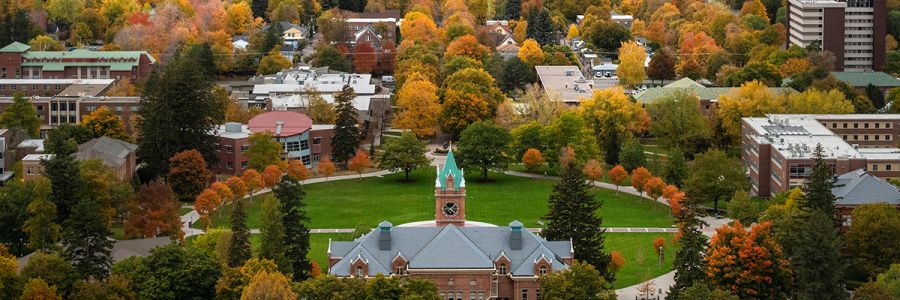A ‘Tradition of Excellence’: Big Ideas and Bold Actions Shaped the 1980s
From a new fine arts building and football stadium to a record-breaking campaign to meet vital needs, donors redefined what private giving could achieve at UM.
July 21, 2025
This story is part of “75 Years of Impact,” a celebration marking the University of Montana Foundation’s 75th anniversary. Throughout the year the Foundation will share stories illustrating the profound impact of donors’ philanthropy at the University of Montana across the decades. To learn more visit SupportUM.org/UMF-75.
Amid the University of Montana’s Homecoming celebration in October 1984, the UM Foundation launched what was hailed in a news release as “one of the most ambitious private fundraising ventures in Montana history.”
The “Extending a Tradition of Excellence” campaign marked the Foundation’s first comprehensive, multiyear effort to generate donor support for a broad-based list of the University's long-term institutional needs — and it signaled a new chapter of giving at UM.
The timing was critical. By the mid-1980s, the University was reprioritizing and reevaluating its funding model, and philanthropy had become key to elevating UM’s mission.
“It was apparent that a campaign would be necessary if we were to maintain our traditional margin of excellence in the years ahead,” said then-University President Neil S. Bucklew, in the release. “The goals of the campaign all represent significant opportunities to build on our strengths — but we’ve got to do it now.”
The “Extending a Tradition of Excellence” campaign offered donors the opportunity to become part of the UM tradition with forward-thinking gifts to the Foundation supporting many impact areas fundamental to the University’s success.
Alumni and friends responded in record numbers, inspiring sharp increases in volunteer participation and hands-on involvement from the Foundation’s Board of Trustees.
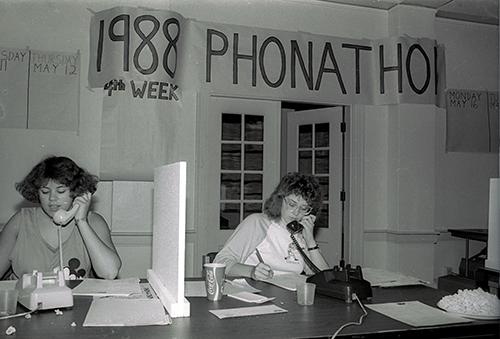
In its first four months, the campaign garnered six-figure gifts from several foundations and corporations, along with many individual and anonymous contributions.
Major campaign victories included:
- Fortifying UM’s Excellence Fund, comprised of gifts given by donors to increase the UM’s President's ability to address high-priority needs and opportunities as they arise.
- Providing critical support for student scholarships. Donor generosity was instrumental in boosting support, including uplifting the Presidential Scholarship Program and Montana University System Honors merit scholarships, as well as need-based scholarships, ensuring that UM had the resources to assist all prospective students, elevating impact of the Foundation’s scholarship endowment beyond the 500 students receiving scholarship awards prior to campaign launch.
- Strengthening what Bucklew called the University's "Centers of Excellence," including the Montana Repertory Theater, Bureau of Business and Economic Research, Flathead Lake Biological Station and Lubrecht Experimental Forest.
- Administering crucial maintenance and additions to the archives and special collections at the library.
- Inspiring support for faculty positions, including an endowed professor position in forestry.
- Solidifying programming, fellowships and academic partnerships at the newly formed Maureen and Mike Mansfield Center, which was established through an act of Congress in 1983 to further the University's global education and public service outreach, and to honor the Mansfields’ commitment to international relations and democracy.
- Supporting Grizzly sports teams and student athletes through contributions to scholarships, facilities and team programs. This aid prioritized academic achievement and leadership development among student athletes, while ensuring that Grizzly Athletics remained one of UM's most visible and powerful public-facing entities.
By the time the campaign concluded in late 1986, it had raised a reported $7.8 million, surpassing expectations across nearly every area of need.
But “Extending a Tradition of Excellence” was more than a financial and historical milestone for the Foundation and its donors — it reflected the growing spirit of collaboration at UM during the ’80s.
Powering Progress: A Giant Leap for Philanthropy
Nationwide, private giving to higher education was on the rise. At the University, donors were thinking bigger than ever before about how to shape UM’s future as an innovative and accessible destination for students and faculty.
By 1983, Foundation records indicate giving to the University's Excellence Fund had increased almost 100% and alumni participation had risen over 146% since the end of the ’70s.
That steadfast dedication would power the school through a decade of unprecedented growth, setting new standards for fulfilling student and faculty needs, while completing truly iconic facility upgrades.
Even before the official launch of “Extending a Tradition of Excellence,” in 1984, the early ’80s saw donors, Trustees and University leaders begin to revolutionize the role of philanthropy at UM.
Among the first major successes of this exciting era: A new home for the fine arts.
Fine Arts Center Sets the Tone
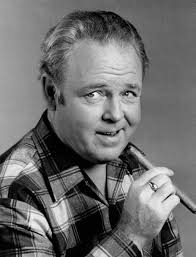
Foundation Trustees and donors recognized the need for a new space to nurture the University’s growing fine arts programs as early as the 1970s. However, the economic adversity of the time forced leaders to pause initial fundraising for nearly a decade.
When the effort resumed with invigorated energy and ambition in 1981, things moved at lightning speed.
That spring, the Board authorized an initiative to raise $1.1 million to supplement $7.5 million in public funding for a new building dedicated to drama, dance, television and radio broadcasting.
By August 1982, donors contributed $1.23 million. More than 150 volunteers contacted over 100 corporations and foundations in 30 cities, many within Montana. The initiative attracted 1,149 individual donors, 616 of whom were giving to UM for the first time — a testament to increasing donor engagement.
Notably, actor Carroll O’Connor, a 1956 UM alumnus and his wife, Nancy, played a pivotal role. They hosted fundraising events in Los Angeles and sent personalized appeals to fellow alumni using stationery featuring the name of O’Connor’s legendary television character, Archie Bunker.
The Foundation also partnered with the Alumni Association to build wide-reaching community support through a “buy a seat” campaign, selling 602 theater seats at $450 each and contributing more than $225,000 to the final total.
Construction on the Performing Arts and Radio/Television Center began in October 1982 and the building was dedicated in October 1985.
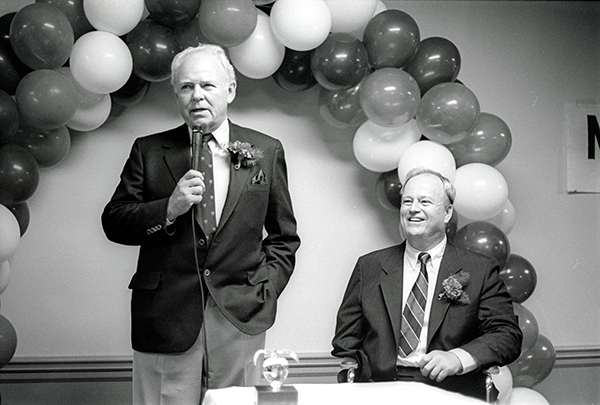
At the time of the PAR/TV Center’s completion, Bucklew lauded the initiative’s success in galvanizing the commitment of Trustees, attracting new donors and demonstrating that Montanans and alumni across the country were eager to invest in the University’s future.
He cited these and similar factors as essential to building momentum that led to the inception and ultimately the landmark success of the “Extending a Tradition of Excellence" campaign.
In 2025, the PAR/TV Center remains a dynamic cultural hub, home to academic programs, live performances and public broadcasting that serve both campus and the state.
It also stands as a triumph of public-private partnership — combining state investment with philanthropic support to achieve a shared vision for the University. Today, public dollars and private generosity continue to work together to make major improvements in facilities, funding and research at UM.
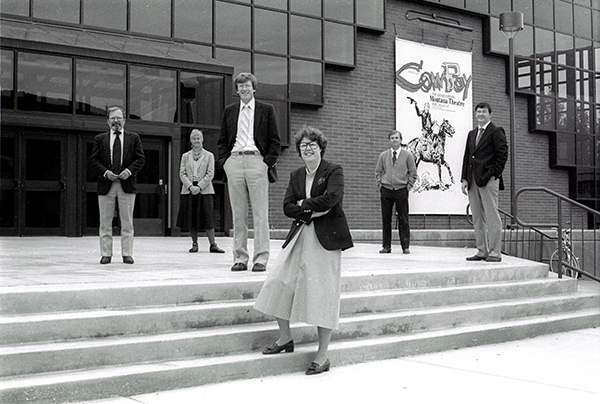
Putting Montana Football on the Map
Dornblaser Field, located roughly a mile south of UM on Higgins Avenue, had served as the Montana Grizzlies’ home turf since 1968 — but by the early ’80s, momentum was building to bring football back to campus.
In July 1983, plans to construct a new stadium at the base of Mount Sentinel were unanimously approved by the Campus Development Committee, sparking a project that would forever reimagine the scope and heart of Griz Nation.
Community and alumni enthusiasm was high, and under the umbrella of the “Extending a Tradition of Excellence” campaign, passionate donors rallied to pledge nearly $1 million by early 1985.
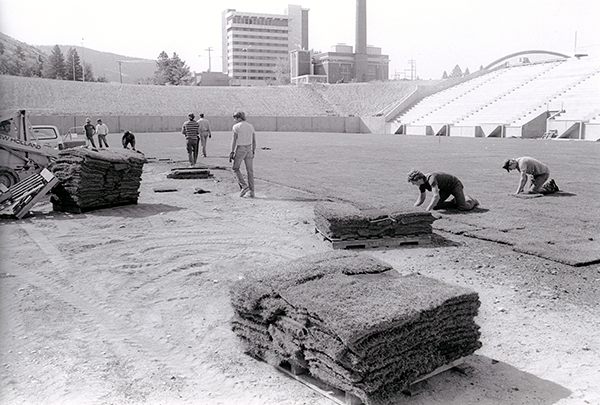
The stadium drive reached its defining moment on Aug. 14, 1985, with the announcement of an additional $1 million gift from Dennis and Phyllis Washington and the Washington Corporation. It was the largest single corporate contribution in the UM Foundation’s history to that point and the largest gift of the decade.
During the gift announcement ceremony, Dennis Washington said he believed the University deserved a stadium that “mirrored its pride and values.”
To honor this vital support, the new facility was named Washington-Grizzly Stadium.
The stadium opened for the 1986 season and was dedicated in an on-field ceremony during an Oct. 18 home game against Idaho State University.
A new era had begun for the Griz.
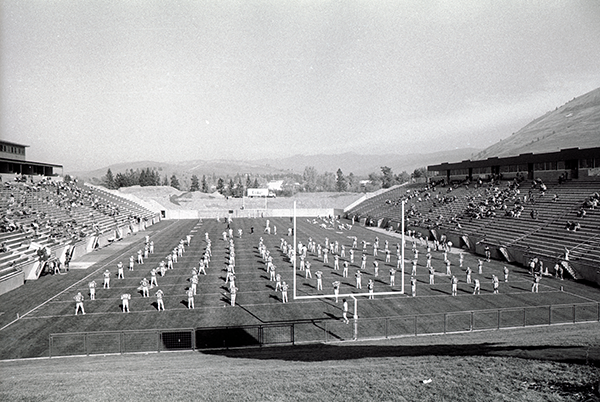
Washington-Grizzly Stadium opened for the 1986 season and was dedicated in an on-field ceremony during an Oct. 18 home game against Idaho State University.
Known for its unmatched fan energy, electric atmosphere and formidable home-field advantage, Washington-Grizzly Stadium soon became one of the most respected venues in college football. By the end of the 2024 season, the Grizzlies had amassed a home record of 236-37 at the stadium.
Today, after a series of expansions during the ensuing decades, the stadium seats more than 25,000 and is regarded as one of the loudest in the nation. Along with the iconic Main Hall clock tower, the Grizzly Bear statue on the Oval and Mt. Sentinel’s “M,” it stands as one of the University’s signature features.
A Decade of Transformational Gifts
By the end of the 1980s, the UM Foundation and its donors had made momentous progress. The decade saw a surge in major gifts from individuals, corporations and foundations. These diverse and visionary citizens, families and organizations were finding strategic ways to participate and make an impact on areas they felt passionate about.
In addition to the Washington Corporation’s gift to the stadium, donors contributed a wide range of gifts during the “Extending a Tradition of Excellence” campaign. Some examples included:
- 1981: Funds from the Excellence Fund drive, including support from major newspapers across the state, provided $30,000 to the UM journalism school to purchase state of the art electronic editing equipment, enhancing professional development and practical training for student journalists.
- 1981: The UM chapter of the Delta Delta Delta sorority and its alumni Theta Rho Home Association gifted $210,000 to benefit the Maureen and Mike Mansfield Library upon the chapter’s closure.
- 1983: The children of Mr. and Mrs. A.M. Mikalson established a $105,000 endowment in their parents’ names to provide annual awards to students majoring in forestry. These scholarships are still awarded today.
- 1988: The Stella Duncan Memorial Fund was established to assist medical research and education.
The ’80s stood as a decade that reshaped campus and expanded the possibilities of what private giving could achieve at the University of Montana.
Through capital campaigns, substantial gifts and a steadily growing base of alumni and donors, the UM Foundation helped further cultivate the University’s legacy of excellence and set the stage for a bold and inspiring future.
To learn more about the Foundation’s 75th anniversary and read feature stories spanning the decades, please visit SupportUM.org/UMF-75.
The information on this website was compiled from a variety of sources, including records held by the UM Foundation and the Maureen and Mike Mansfield Library Archives and Special Collections. The UM Foundation has made its best efforts to provide an accurate representation of events, people, entities, names, activities and data. However, the information presented should not be considered a definitive historical record.
